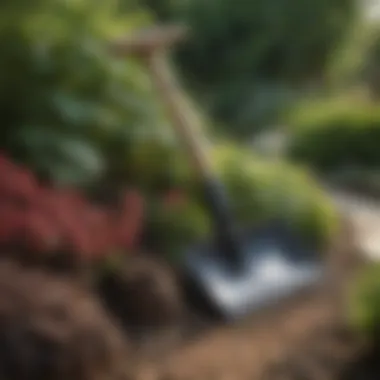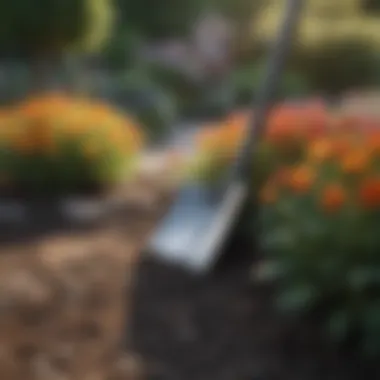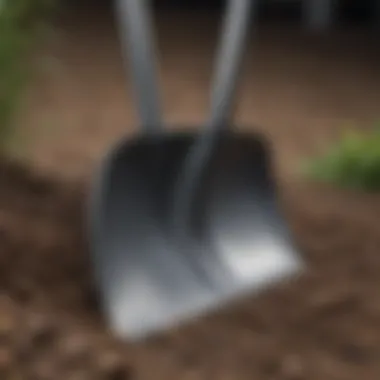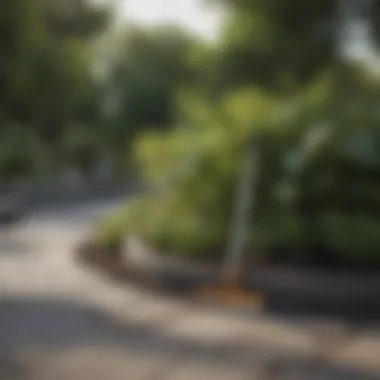Mastering Half Moon Shovel Edging in Landscaping


Intro
In the realm of landscaping, half moon shovel edging represents a practical yet often overlooked technique. This method not only defines garden beds but also serves as a structural element in landscape design. By understanding the nuances of half moon shovel edging, homeowners and gardening enthusiasts can create aesthetically pleasing and functional outdoor spaces. This article aims to provide insights into the definition, benefits, installation methods, and design considerations associated with this edging style.
Design Trends
Current Popular Styles
Half moon shovel edging is gaining traction for its versatility and clean look. The trend now emphasizes natural materials and organic shapes that enhance rather than overpower the landscape. Properties often feature curved lines that mimic the natural contours of the land, providing a harmonious transition between different areas. This technique allows for smooth division between grass, flower beds, and pathways, creating a seamless flow throughout the garden.
Another popular trend is integrating various textures. Using granite, stone, or clay for edging can contrast beautifully with the lush greenery of plants. Homeowners are opting for a mix of modern and rustic styles. This creates a unique blend that adds character and personal touch to the garden.
Color Palettes for Modern Spaces
When considering color palettes in conjunction with half moon shovel edging, earth tones dominate the landscape. Shades of beige, taupe, and rich browns from mulch or natural stone resonate well with most plant varieties. These colors can unify the space while providing a clean backdrop for colorful flowers.
The trend is also leaning towards dark hues. Deep charcoal or slate colors in stones can provide a dramatic edge against bright plant life. As more homeowners seek to enhance their outdoor experience, color choice will continue to be an important aspect of landscaping design.
"Effective use of color can transform a mundane garden into a vibrant visual experience."
Intro to Half Moon Shovel Edging
Landscaping is not just about planting flowers and mowing lawns. It includes several techniques that enhance the beauty and functionality of outdoor spaces. One of these techniques is half moon shovel edging. This method is crucial for creating defined borders and maintaining organized garden layouts. In essence, half moon shovel edging helps in distinguishing different areas in the landscape, which is vital for both aesthetics and practical purposes.
The significance of half moon shovel edging lies in its dual functionality. First, it improves the aesthetic appeal of any garden or yard. By creating a slight curve or defined line, it adds visual interest and structure. Second, it assists in garden maintenance. A clear demarcation between flower beds and lawn areas ensures that grass does not invade flower beds, allowing for healthier plants and easier mowing.
Another important aspect is the ease of installation. This edging method requires minimal tools and can be done by homeowners without needing professional help. The benefits are many, covering not just beauty but also time-saving elements in upkeep. In this article, we will explore the depths of half moon shovel edging, from its definition to historical context, providing a comprehensive understanding that will benefit enthusiastic gardeners and homeowners alike.
Defining Half Moon Shovel Edging
Half moon shovel edging refers to a technique where a half moon-shaped shovel is used to create distinct borders in landscaping. The shovel cuts into the soil, carving out a shallow trench that neatly separates different areas of a garden. This method effectively outlines flower beds, pathways, or any garden element that needs definition.
The half moon shape of the tool allows for precise cutting along curves and corners, making it particularly suitable for gardens with intricate designs. This edging technique not only serves to beautify the garden but also offers practical benefits such as controlling weeds and grass growth.
Historical Context and Usage
Historically, edging techniques have been around for centuries. The use of tools similar to the half moon shovel dates back to ancient civilizations who sought to organize their agricultural spaces. Over time, landscaping techniques evolved, and the half moon shovel became a favored tool for home gardeners.
Notably, its application has expanded beyond mere aesthetics. Gardens that employ this method show improved organization, which is essential in both residential and commercial landscaping. It represents a bridge between functionality and design, reflecting a broader trend in landscaping towards more structured and purposeful outdoor spaces.
"Landscaping is about creating spaces that are not only beautiful but also functional. Half moon shovel edging exemplifies this principle."
Benefits of Half Moon Shovel Edging
Half moon shovel edging plays a significant role in enhancing the overall appearance and function of a landscape. This technique provides both aesthetic appeal and functional benefits, which are crucial for any landscaping project. Understanding these benefits leads to better decision-making for homeowners and gardening enthusiasts. Below, we will explore the various advantages offered by half moon shovel edging.
Aesthetic Advantages
The primary function of half moon shovel edging is to add visual interest to outdoor spaces. This method creates a defined border between different areas such as flower beds and lawns. The clean, rounded appearance of the edging enables seamless transitions between various landscape features.
Moreover, half moon shovel edging can be tailored to suit individual design preferences. Homeowners can choose to leave the edges natural or create a uniform look by leveling them with the surrounding soil. This versatility allows for creative possibilities that can enhance the beauty of any garden. Its simple design is both timeless and elegant, making it a suitable choice for various landscaping styles.
Additionally, the use of this form of edging can help draw attention to the plants and features within the bordered area. By providing a contrast to the surrounding environment, the plants seem more vibrant and healthy. As a result, one finds that gardens with this edging technique often appear more polished and well-maintained.


Functional Benefits for Garden Maintenance
Beyond aesthetic appeal, half moon shovel edging also contributes significantly to garden maintenance. This edging acts as a barrier to prevent grass and weeds from creeping into flower beds or vegetable gardens. As a result, it reduces the time and effort needed for weeding and mowing, making garden upkeep less labor-intensive.
The clear demarcation established by the half moon shovel edging encourages a more organized layout. With well-defined boundaries, gardeners can effectively plan planting arrangements and maintain crop rotations with ease. The precision offered by this edging method contributes to an overall more effective management of garden space.
Furthermore, this edging helps retain soil moisture. By preventing soil from washing away, it aids in maintaining an optimal environment for plant growth. This care for soil health ensures better yields in vegetable gardens and thriving blooms in ornamental settings.
Durability and Longevity
Durability is another important factor in the appeal of half moon shovel edging. Made typically from steel, aluminum, or high-quality plastic, this edging tends to withstand weather extremes and remain intact over the years. Unlike wooden or less sturdy materials, it does not rot or deteriorate quickly. This resilience assures homeowners that their investment in landscaping will stand the test of time.
When installed correctly, half moon shovel edging often requires minimal maintenance. This further proves cost-effective in the long run, as replacement or repairs become infrequent tasks. It is a wise investment for any landscape.
Materials and Tools Required
In the practice of half moon shovel edging, selecting the right materials and tools is crucial. This section aims to highlight the appropriate choices that can facilitate an efficient and aesthetic outcome in landscaping. Understanding these components ensures that you can successfully implement half moon shovel edging in your garden or yard. The right tools and materials can simplify the installation process and enhance the durability and visual appeal of your landscaping project.
Choosing the Right Tools
Choosing the right tools is the first step to achieving a successful installation of half moon shovel edging. The central tool for this task is the half moon shovel itself, which is designed for creating clean edges and trenches. This tool features a curved blade with a distinct shape that allows for ease of maneuvering through soil and grass.
In addition to the half moon shovel, several other tools might be required:
- Garden Rake: Useful for leveling soil and removing debris.
- Garden Hose or String Line: Assists in marking out straight edges or curves for proper alignment.
- Landscaping Fabric (Optional): Can be employed to prevent weeds in the bordered area.
- Hand Trowel: Great for smaller adjustments and detailed work.
- Level or Straight Edge: Ensures that edging remains even throughout the installation.
Selecting high-quality tools ensures longevity and ease of use. Investing in durable equipment may save time and effort during the installation process. Poor tools can lead to frustration and unsatisfactory results, so choose wisely.
Material Options for Edging
The materials you choose for edging also play a critical role in the overall functionality and appearance of your landscaping. Here are some common options:
- Natural Stone: Offers a timeless look and durability. It blends seamlessly with natural landscapes but can be more expensive.
- Brick or Pavers: These materials provide structural integrity and varied aesthetic options. They are available in numerous designs and colors, allowing customization.
- Metal Edging: Steel or aluminum edging offers a modern and sleek appearance. It is particularly good for clean lines but may need more maintenance to prevent rust.
- Plastic Edging: Lightweight and often cheaper, plastic can be a practical choice for DIY projects. However, it may not hold up as well over time compared to other materials.
- Wood: This option gives a rustic feel, but wood can deteriorate when exposed to moisture unless treated properly.
Selecting the right material depends on factors such as budget, desired aesthetic, and local climate conditions. Ensure that the material chosen aligns with the purpose of edging, whether for decorative purposes or functional barriers.
"The right combination of tools and materials not only simplifies the installation process but also enhances the visual quality of your garden space."
Installation Process
The installation process is a pivotal phase in implementing half moon shovel edging. This part is critical as it sets the stage for both the functional and aesthetic benefits that this form of edging provides. Proper installation ensures that the edging remains stable while also enhancing the overall design of the landscape. Addressing elements such as site preparation, step-by-step installation methods, and common mistakes helps women and men alike to achieve successful results.
Site Preparation and Planning
Before starting the installation of half moon shovel edging, careful planning is essential. This phase includes identifying the purpose of the edging. Are you aiming to create distinct garden beds or pathways? Such questions guide the layout decisions.
- Assess the Area: Observe the site where you want to install the edging. Check for slopes, existing plants, and soil conditions.
- Marking the Outline: Using string or garden stakes, mark the desired shape and line of the edging. This provides a clear visual reference.
- Soil Condition: Clarify the type of soil you have. If it is compacted or rocky, you might need extra tools like a pick or additional effort to break it down.
This preparation avoids unexpected challenges during the actual installation phase.
Step-by-Step Installation Guide
With preparation complete, follow these systematic steps for installation:


- Digging the Trench: Utilize your half moon shovel to create a trench along the marked outline. Make the trench about six inches deep and wide enough to accommodate the edging.
- Placement of the Edging: Position the half moon shovel edging within the trench. Ensure it is straight and level, adjusting as necessary.
- Back-Filling the Trench: After placing the edging, back-fill soil around it. Use your foot or a tamper to pack the soil firmly. This helps to hold the edging in place firmly.
- Level the Surface: Check the surface for evenness. The top of the edging should be slightly above the soil to discourage erosion and maintain an appealing visual line.
- Final Touches: Once everything is in place, smooth the soil and tidying up the surrounding area completes the job.
By following these steps carefully, your half moon shovel edging will be well integrated into the landscape, serving its purpose for years.
Common Mistakes to Avoid
During the installation of half moon shovel edging, some common errors can lead to subpar results:
- Neglecting Site Assessment: Not assessing the soil and existing landscape can result in improper installation.
- Ignoring Leveling: Failing to ensure the edging is level can cause water pooling, leading to weed growth and erosion.
- Skipping Back-Filling: Disregarding the importance of packing soil around the edging can lead to instability.
- Rushing the Process: Taking shortcuts may create visible flaws in the overall design and functionality of the edging.
By paying attention to these common pitfalls, you can ensure a successful installation that meets your landscaping needs and aesthetic desires.
"Proper installation of half moon shovel edging provides the foundation for a visually appealing and functional landscape design."
Design Considerations
When integrating half moon shovel edging into landscaping, design considerations play a crucial role. This technique not only enhances the visual appeal of gardens but also ensures functionality. Thoughtful design affects how edging interacts with plants and paths, which can maximize both beauty and practicality in outdoor spaces.
Integrating Edging with Landscaping Elements
Half moon shovel edging serves as a powerful tool to unify various elements of landscaping. It can help delineate flower beds, pathways, and other distinct areas within a garden. When integrating this edging, homeowners must consider existing features such as trees, shrubs, and pavers. For example, placing edging around curved flower beds can emphasize their shape, drawing attention to the plants within.
Important factors in this process include:
- Choosing Complementary Materials: The material of the edging should harmonize with other landscaping elements. For instance, if a path is made of stone, an edging that mirrors or contrasts elegantly with this can create a cohesive look.
- Creating Flow: The line of edging should follow natural contours and movement in the landscape. This makes the design feel more organic and less rigid, enhancing the overall environment.
"A well-placed edge defines space without overwhelming it, leading the eye across the landscape naturally."
Balancing Functionality and Aesthetics
Achieving a balance between functionality and aesthetics is essential when implementing half moon shovel edging. Functionality often centers around practical aspects, such as soil retention and weed control, while aesthetics focuses on the overall look and feel of the garden.
To find this balance, consider the following:
- Purpose of the Edging: Decide the primary goal of the edging. Is it to keep mulch in place, define paths, or improve the appearance of flower beds? Defining this first helps in selecting the right style and placement.
- Visual Harmony: The edging should enhance the garden's beauty rather than detract from it. Color, texture, and shape should be in tune with the surrounding environment. For instance, if the garden features soft, curved lines, the edging should reflect this rather than introducing hard angles.
Maintenance and Care
Maintaining half moon shovel edging is crucial for the longevity and appearance of your landscaping. Without proper care, the edges can become overgrown, uneven, or even damaged. Regular maintenance ensures that your garden remains both functional and visually appealing. It is essential to think of edging not just as a boundary but as a contributing element to your overall landscape design.
Regular Maintenance Tasks
Regular maintenance tasks are necessary to keep half moon shovel edging in optimal condition. Specific actions are required to ensure that the appearance of the edging stays neat. These tasks include:
- Weeding: Regularly check for weeds that may encroach upon your edges. Pull them out by hand or use a hoe to prevent them from taking over.
- Trimming Grass: Grass can grow over the edging, leading to a messy look. Use a trimmer to keep the grass just outside the edging line neatly cut.
- Checking Edges: Inspect the edging for any signs of wear or damage. If you find any issues, address them promptly to avoid more extensive repairs later.
- Repacking Soil: Over time, soil can settle beneath the edging and may require additional soil to maintain a level appearance.
Implementing these tasks regularly not only keeps the physical structure intact but also enhances the visual elements of your landscaping.
Seasonal Considerations
Understanding seasonal changes is vital for effective maintenance of half moon shovel edging. Different seasons present unique challenges and tasks:
- Spring: This is a great time to assess the overall condition of your edging. Remove any winter debris and prepare the area for growth. Consider applying mulch around the edges to help retain moisture and suppress weeds.
- Summer: Increased growth rates mean more frequent weeding and mowing. Pay close attention to edges as plants can move into undesired areas.
- Fall: This is an ideal time to prepare for winter. Clean up fallen leaves, which can smother plants and promote disease, and inspect for any necessary winter repairs.
- Winter: Although landscape maintenance is less intensive, monitor your edging for damage caused by snow and ice. If possible, protect them with burlap or other coverings to prevent physical harm.


Environmental Impact
Understanding the environmental impact of landscaping practices is crucial for sustainable living. Half moon shovel edging is no different. This method can significantly affect various aspects of the ecosystem surrounding a garden. It promotes better water management, supports plant health, and enhances biodiversity. The importance of edging is not only in aesthetics but in fostering a healthier environment for both plants and local wildlife.
Sustainable Practices in Landscaping
Implementing sustainable practices in landscaping can reduce resource consumption and minimize harm to the environment. Half moon shovel edging plays a vital role in these practices.
- Water Conservation: Properly installed edging can prevent soil erosion and promote efficient water retention. By maintaining defined borders, water remains localized, reducing the need for excessive irrigation.
- Native Plant Promotion: Using this edging technique allows gardeners to create distinct sections for various plant types. This can encourage the use of native plants that are better adapted to local conditions, thus reducing the need for chemical fertilizers or pesticides.
- Waste Reduction: Choosing sustainable materials such as reclaimed stones or recycled rotting wood reduces the ecological footprint. Moreover, it can divert materials from landfills, which is beneficial for the environment.
Encouraging these sustainable practices not only improves the overall appearance of outdoor spaces but also contributes to the larger goal of environmental responsibility.
Soil Health and Landscaping
Soil health is a fundamental element of any successful landscaping endeavor. Half moon shovel edging significantly impacts soil quality and structure.
- Erosion Control: The use of edging protects against soil erosion by providing a barrier. This helps retain nutrients and moisture in the soil, vital for plant growth.
- Improved Microbial Activity: Healthy soil relies on a delicate balance of microbes. By preventing excessive compaction and disturbance, edging can help maintain this balance, fostering a thriving ecosystem for plants.
- Nutrient Management: Edging can help delineate areas for composting, mulching, or specific plants. These sections can be enriched with organic matter, improving soil fertility and contributing to healthier plants.
"Healthy soil is the foundation of a thriving garden. By understanding the importance of soil health, gardeners can make informed decisions that benefit their plants and the environment."
In summary, the integration of half moon shovel edging in landscaping not only beautifies gardens but also enhances ecological sustainability. This dual focus on aesthetics and environmental wellbeing presents homeowners with the opportunity to create harmonious outdoor spaces that contribute positively to the environment.
Cost Analysis
Cost analysis is essential in any landscaping project, particularly when incorporating half moon shovel edging. Understanding financial aspects helps homeowners make informed decisions. It ensures that your landscaping efforts stay within budget while achieving the desired results. Several factors influence the overall cost, including materials, labor, and design complexity.
Estimating Project Costs
Estimating project costs for half moon shovel edging involves a thorough assessment of various components. Begin by evaluating the size of the area intended for edging. Larger areas naturally require more materials, increasing expenses.
Next, consider the materials for edging, which can include natural stone, concrete, or recycled materials. Each option comes with distinct price points. Natural stones like granite or flagstone tend to be pricier compared to basic concrete products.
Labor costs are another necessary consideration. If you plan to hire professionals, get quotes from multiple sources to understand the market rate. Alternatively, if this is a DIY project, calculate how much time you can dedicate, as your time has a value, too. Ultimately, factor in any equipment rental costs if you need tools not already available at home.
Budget-Friendly Options
There are several budget-friendly options when implementing half moon shovel edging without compromising quality or aesthetic appeal. First, consider using recycled materials. Items like old bricks or stones can serve as a functional and attractive edging solution. They're often available at a low cost or even free if sourced from local renovation projects.
Secondly, look into concrete options. Pre-made concrete edging is a cost-effective alternative. It provides durability while being easier to install than traditional methods.
Additionally, educate yourself about seasonal sales or discounts from local suppliers. Purchasing materials during off-peak seasons can significantly lower total costs.
In summary, while cost analysis is vital, being resourceful and creative can lead to successful landscaping projects involving half moon shovel edging without breaking the bank.
"Understanding costs is key to achieving great results in landscaping without financial stress."
End
The conclusion of this article holds significant weight in understanding the full scope of half moon shovel edging in landscaping. It encapsulates the essential elements covered throughout the narrative, providing a final frame of reference for homeowners and gardening enthusiasts.
Recap of Key Points
A few primary aspects stand out as particularly relevant when considering the practical applications of half moon shovel edging:
- Definition and Historical Context: Understanding what half moon shovel edging is and how it has evolved lays the foundation for its use. This technique is not simply a modern trend but has historical significance in landscaping practices.
- Benefits: The aesthetic enhancement and functional advantages such as soil retention and ease of maintenance are pivotal points. Recognizing these benefits can guide homeowners in making informed decisions about their outdoor spaces.
- Installation Process: A clear step-by-step guide for installation is invaluable for correct application. Knowing both the process and common pitfalls helps in achieving the desired results without unnecessary frustration.
- Design Considerations: It's essential to integrate edging thoughtfully with other landscaping elements. A well-designed space that balances function and beauty elevates the visual appeal of any garden.
- Maintenance Recommendations: Understanding regular maintenance tasks and seasonal considerations is key to ensuring the longevity and functionality of the edging.
Final Thoughts on Half Moon Shovel Edging
Half moon shovel edging presents a practical solution for various landscaping challenges. By combining simplicity of design with effectiveness, it serves as a functional tool that enhances the overall look of the landscape. The investment in this technique not only benefits the immediate aesthetics but also promotes healthier garden ecosystems, thereby inviting a more sustainable approach to landscaping.
Embracing half moon shovel edging in your landscaping project is not merely about curbing garden boundaries. It is about cultivating a space that reflects personal style while offering the necessary utility. As you apply this technique, consider the ongoing care and integration within your larger landscaping vision. Through mindful application and maintenance, the results can be both beautiful and enduring.















